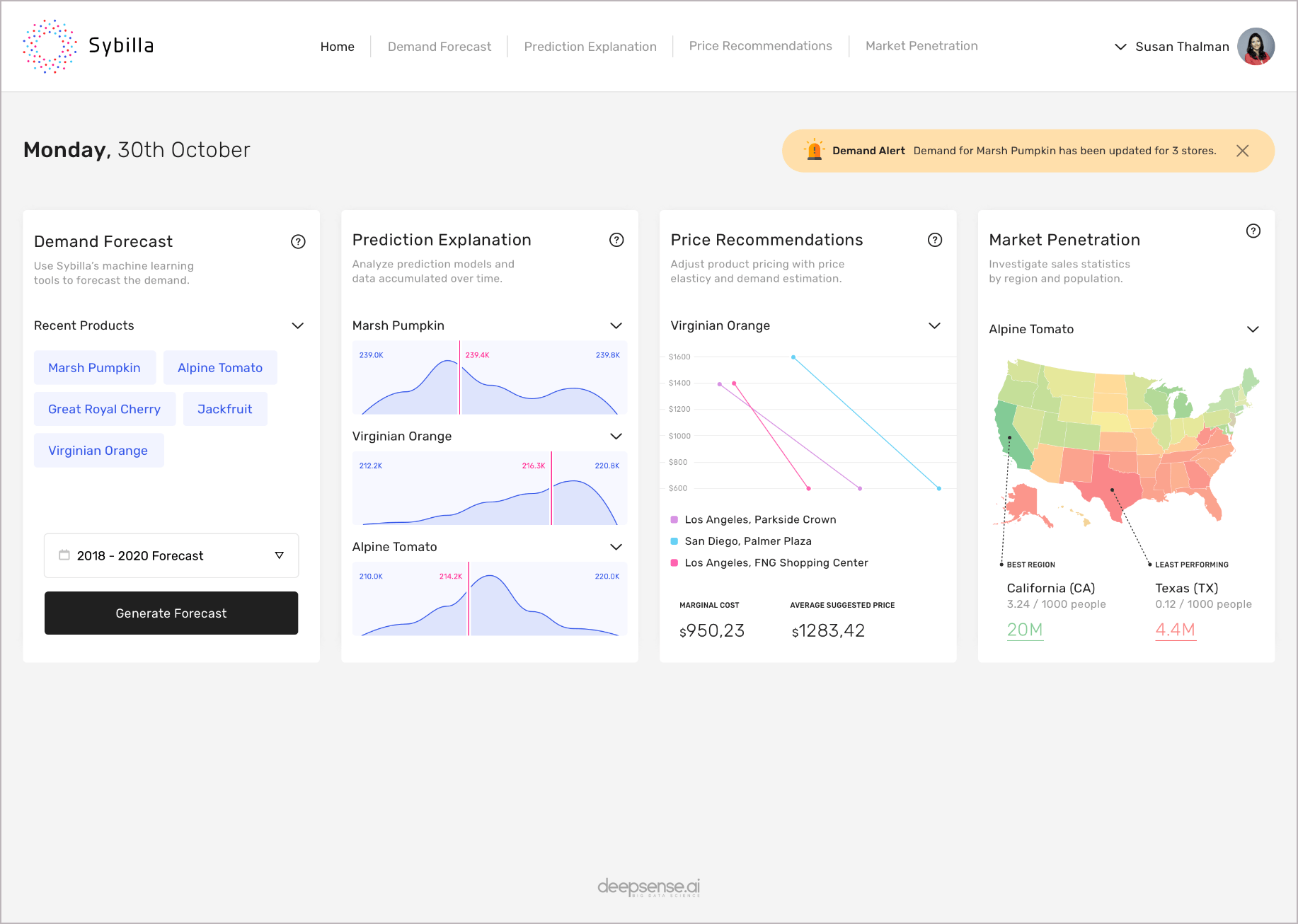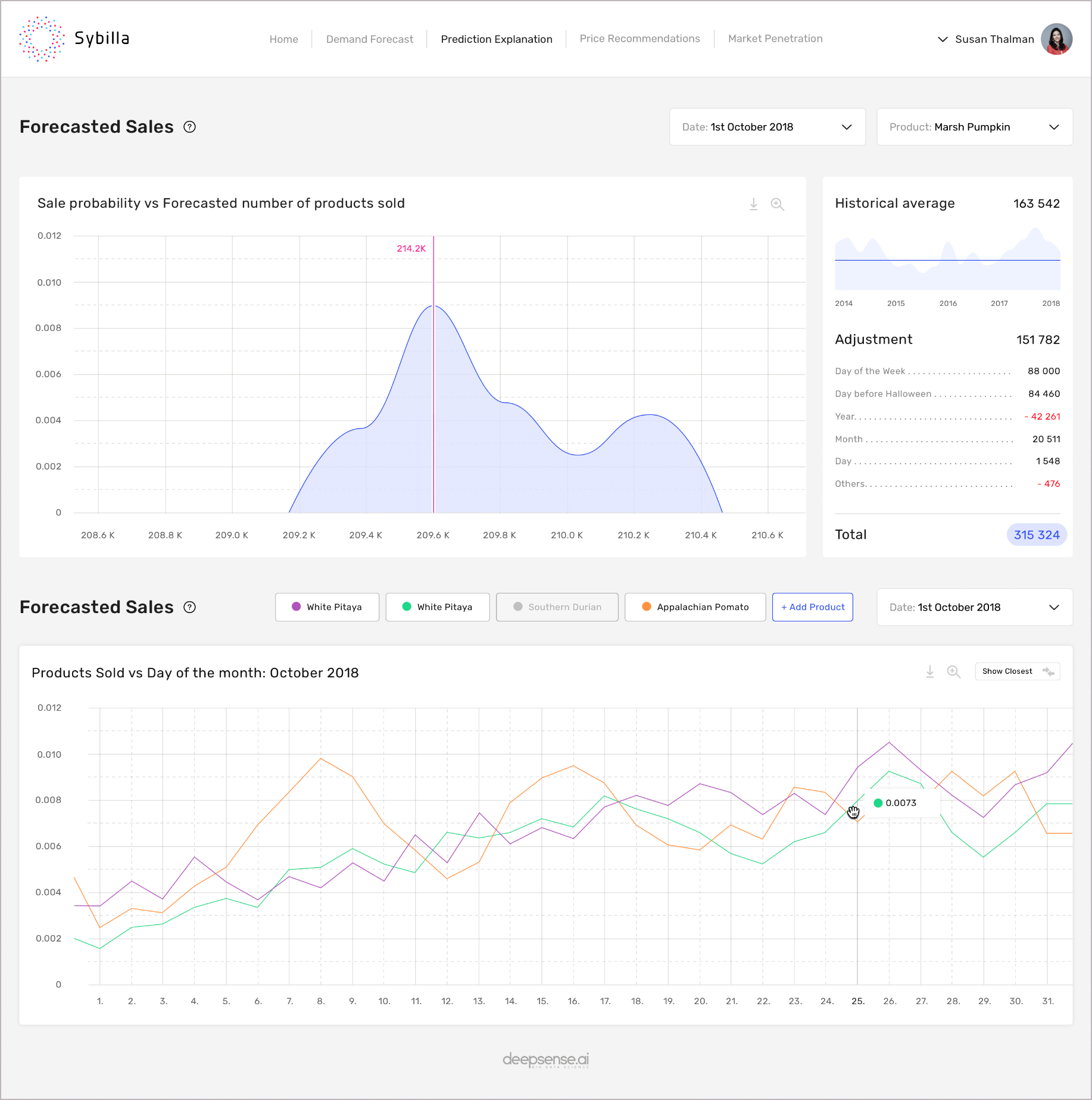A comprehensive guide to demand forecasting
Everything you need to know about demand forecasting – from the purpose and techniques to the goals and pitfalls to avoid.
Essential since the dawn of commerce and business, demand forecasting enters a new era of big-data rocket fuel.
What is demand forecasting?
The term couldn’t be clearer: demand forecasting forecasts demand. The process of predicting the future involves processing historical data to estimate the demand for a product. An accurate forecast can bring significant improvements to supply chain management, profit margins, cash flow and risk assessment.
What is the purpose of demand forecasting?
Demand forecasting is done to optimize processes, reduce costs and avoid losses caused by freezing up cash in stock or being unable to process orders due to being out of stock. In an ideal world, the company would be able to satisfy demand without overstocking.
Demand forecasting techniques
Demand forecasting is an essential component of every form of commerce, be it retail, wholesale, online, offline or multichannel. It has been present since the very dawn of civilization when intuition and experience were used to forecast demand.
More recent techniques combine intuition with historical data. Modern merchants can dig into their data in a search for trends and patterns. At the pinnacle of these techniques, are demand forecasting machine learning models, including gradient boosting and neural networks, which are currently the most popular ones and outperform classic statistics-based methods.
The basis of more recent demand forecasting techniques is historical data from transactions. These are data that sellers collect and store for fiscal and legal reasons. Because they are also searchable, these data are the easiest to use.
How to choose the right demand forecasting method – indicators
As always, selecting the right technique depends on various factors, including:
- The scale of operations – the larger the scale, the more challenging processing the data becomes.
- The organization’s readiness – even the large companies can operate (efficiency aside) on fragmented and messy databases, so the technological and organizational readiness to apply more sophisticated demand forecasting techniques is another challenge.
- The product – it is easier to forecast demand for an existing product than for a newly introduced one. When considering the latter, it is crucial to forming a set of assumptions to work on. Owning as much information about the product as possible is the first step, as it allows the company to spot the similarities between particular goods and search for correlations in the buying patterns. Spotting an accessory that is frequently bought along with the main product is one example.
How AI-based demand forecasting can help a business
Demand forecasting and following sales forecasting is crucial to shaping a company’s logistics policy and preparing it for the immediate future. Among the main advantages of demand forecasting are:
- Loss reduction – any demand that was not fulfilled should be considered a loss. Moreover, the company freezes its cash in stock, thus reducing liquidity.
- Supply chain optimization – behind every shop there is an elaborate logistics chain that generates costs and needs to be managed. The bigger the organization, the more sophisticated and complicated its inventory management must be. When demand is forecast precisely, managing and estimating costs is easier.
- Increased customer satisfaction – there is no bigger disappointment for consumers than going to the store to buy something only to return empty-handed. For a business, the worst-case scenario is for said consumers to swing over to the competition to make their purchase there. Companies reduce the risk of running out of stock–and losing customers–by making more accurate predictions.
- Smarter workforce management – hiring temporary staff to support a demand peak is a smart way for a business to ensure it is delivering a proper level of service.
- Better marketing and sales management – depending on the upcoming demand for particular goods, sales and marketing teams can shift their efforts to support cross- and upselling of complementary products,
- Supporting expert knowledge – models can be designed to build predictions for every single product, regardless of how many there are. In small businesses, humans handle all predictions, but when the scale of the business and the number of goods rises, this becomes impossible. Machine learning models extend are proficient at big data processing.
How to start demand forecasting – a short guide
Building a demand forecasting tool or solution requires, first and foremost, data to be gathered.
While the data will eventually need to be organized, simply procuring it is a good first step. It is easier to structure and organize data and make them actionable than to collect enough data fast. The situation is much easier when the company employs an ERP or CRM system, or some other form of automation, in their daily work. Such systems can significantly ease the data gathering process and automate the structuring.
The next step is building testing scenarios that allow the company to test various approaches and their impact on business efficiency. The first solution is usually a simple one, and is a good benchmark for solutions to come. Every next iteration should be tested to see if it is performing better than the previous one.
Historical data is usually everything one needs to launch a demand forecasting project, and obviously, there are significantly less data on the future. But sometimes it is available, for example:
- Short-term weather forecasts – the information about upcoming shifts in weather can be crucial in many businesses, including HoReCa and retail. It is quite intuitive to cross-sell sunglasses or ice cream on sunny days.
- The calendar – Black Friday is a day like no other. The same goes for the upcoming holiday season or other events that are tied to a given date.
Sources of data that originate from outside the company make predictions even more accurate and provide better support for making business decisions.
Common pitfalls to avoid when building a demand forecasting solution
There are numerous pitfalls to avoid when building a demand forecasting solution. The most common of them include:
- The data should be connected with the marketing and ads history – a successful promotion results in a significant change in data, so having information about why it was a success makes predictions more accurate. If machine learning was used to make the predictions, the model could have misattributed the changes and made false predictions based on wrong assumptions.
- New products with no history – when new products are introduced, demand must still be estimated, but without the help of historical data. The good news here is that great strides have been made in this area, and techniques such as product DNA can help a company uncover similar products its past/current portfolio. Having data on similar products can boost the accuracy of prediction for new products.
- The inability to predict the weather – weather drives demand in numerous contexts and product areas and can sometimes be even more important than the price of a product itself! (yes, classical economists would be very upset). The good news is that even if you are unable to predict the weather, you can still use it in your model to explain historical variations in demand.
- Lacking information about changes – In an effort to support both short- and long-term goals, companies constantly change their offering and websites. When the information about changes is not annotated in the data, the model encounters sudden dwindles and shifts in demand with apparently no reason. In the reality, it is usually a minor issue like changing the inventory or removing a section from website.
- Inconsistent portfolio information – predictions can be done only if the data set is consistent. If any of the goods in a portfolio have undergone a name or ID change, it must be noted in order not to confuse the system or miss out on a valuable insight.
- Overfitting the model – a vicious problem in data science. A model is so good at working on the training dataset that it becomes inflexible and produces worse predictions when new data is delivered. Avoiding overfitting is down to the data scientists.
- Inflexible logistics chain – the more flexible the logistics process is, the better and more accurate the predictions will be. Even the best demand forecasting model is useless when the company’s logistics is a fixed process that allows no space for changes.
AI in demand forecasting: final thoughts
Demand and sales forecasting is a crucial part of any business. Traditionally it has been done by experts, based on know-how honed through experience. With the power of machine learning it is now possible to combine the astonishing scale of big data with the precision and cunning of a machine-learning model. While the business community must remain aware of the multiple pitfalls it will face when employing machine learning to predict demand, there is no doubt that it will endow demand forecasting with awesome power and flexibility.
Ready to harness the full potential of AI for your business? Opt for our AI consulting services, and let our experts guide you.







